Family, you don’t need a lot of equipment to get started as a baker.
One thing you definitely need, though, is some baking pans. Because you can’t bake bread in your hands.
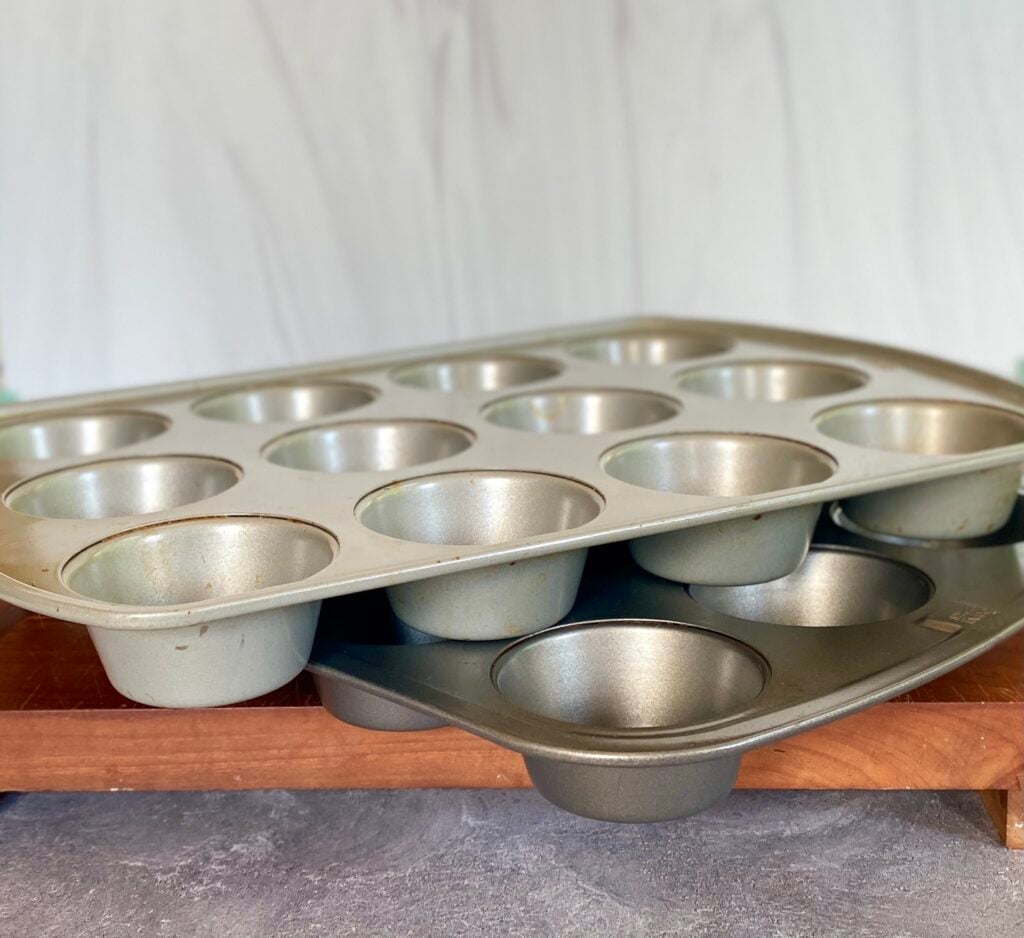
Today, we’re talking about different kinds of baking pans that I use in my kitchen (hint: I LOVE a multipurpose pan), and my recommendations for pans that are the best if you’re just getting started. Because the goal isn’t to go broke on equipment (save your money for great ingredients), but to get great equipment at a reasonable price that does a fantastic job.
I’m excited! Let’s go.
In this Post (It’s…A Lot):
- Basics about Baking Pans
- Sheet Pans and Cookie Sheets
- Pie Plates
- Round Cake Pans
- Bundt Cake Pans
- Glass Baking Dishes
- Sheet Cake Pans
- Loaf Pans
- Muffin Pans
- Best Pans for Beginners
- Conclusion
**Please note that this post contains affiliate links. While I do get paid a small commission if you buy directly from the links on this site, these are all products that I use regularly in my home kitchen and I recommend them with my whole heart.**
Basics about Baking Pans
Okay here’s the deal: there are a lot of bakeware companies and lot of baking pans out here. I get it. Over the course of my baking life, I’ve purchased so-called “starter” bakeware and high-end bakeware. I still have a good mix of both in my kitchen and use them interchangeably.
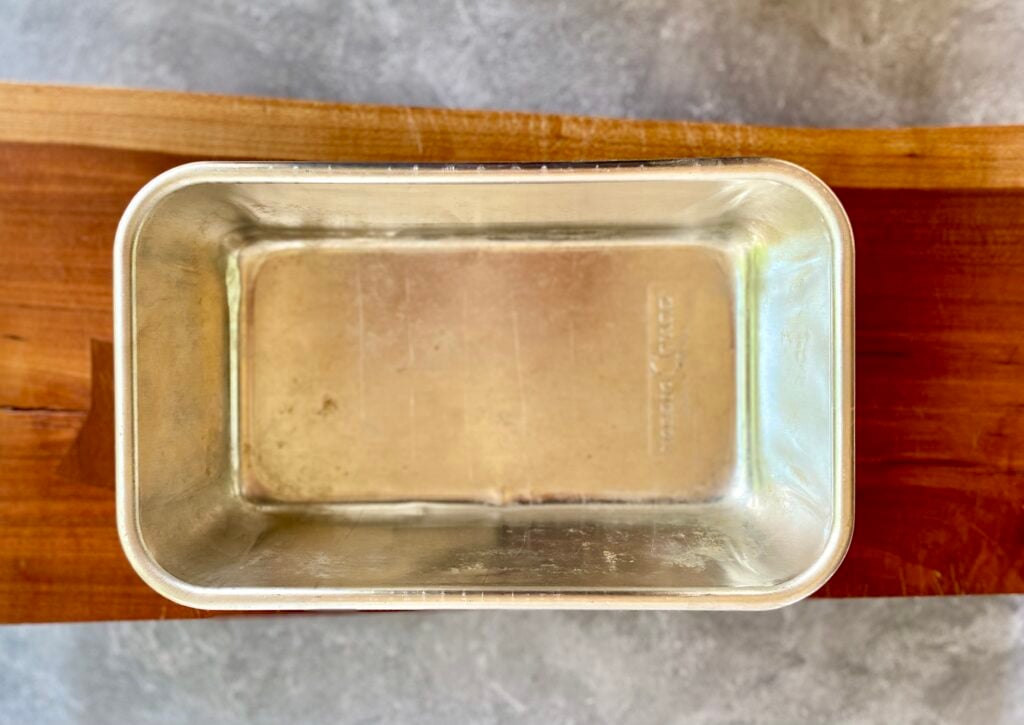
I’ve found a few universal rules that I use when I’m looking for a new pan. Here they are!
- I sometimes prefer light-colored baking pans over dark colored baking pans. This is because light-colored pans reflect more heat away from your food, thus leaving the edges of your completed baked goods lighter in color (or less caramelized). While light-colored pans clearly still get super hot in a 350° oven, they don’t get as hot as dark pans, which means that they’re more forgiving when it comes to browning and burning food. I have both and I’ll explain why when I talk about each kind of pan.
- I love a high-walled pan (unless I’m using a sheet pan). With high-walled pans, you’re more likely to be able to use that pan for multiple purposes. High walls also help shape beautiful dinner rolls and stop oven spills. Because, Friends, there’s nothing less fun in the kitchen than having to run your oven’s auto cleaning function because a cake or pie bubbled over. ::the auto clean function is frighteningly hot as well::
- For baking pans, my absolute favorite brands are Wilton and Nordic Ware. I am not paid to mention their names, but they are my favorites, so I wanted to share them with you! Of all the brands I’ve tried (and there have been many, many brands), these two have given the most consistent product without breaking my wallet. I know what to expect with these baking pans and that’s been a huge boost to my confidence as a baker.
Since my baking beginnings were…let’s just say “less than great”, I hold onto every ego-boosting win with a vise grip. Using these three simple rules for buying baking pans has been one of those huge wins.
Onto the pans! If you want the cheat code for each kind of pan, check out the TL;DR summary at the end of each section.
Sheet Pans and Cookie Sheets
Let me first apologize for the state of my sheet pans, y’all. They are beat to h*ll. But that’s a testament to exactly how much I use them. Even with parchment paper (which I use religiously), sheet pans will eventually show their age. I’m proud of my sheet pans!
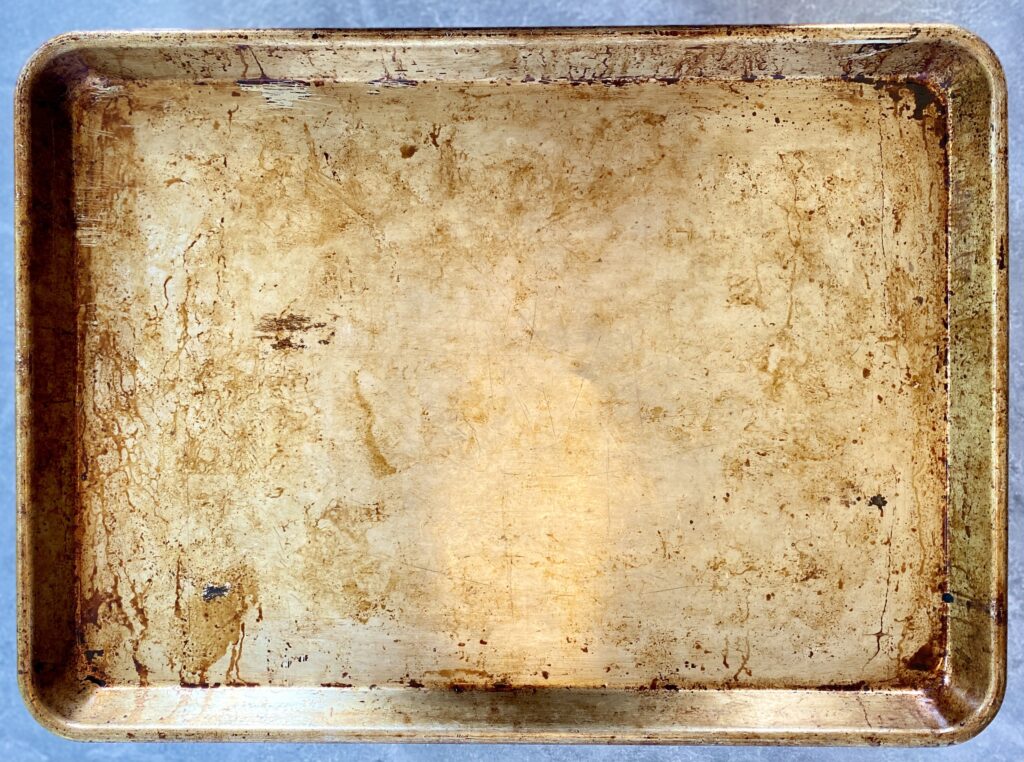
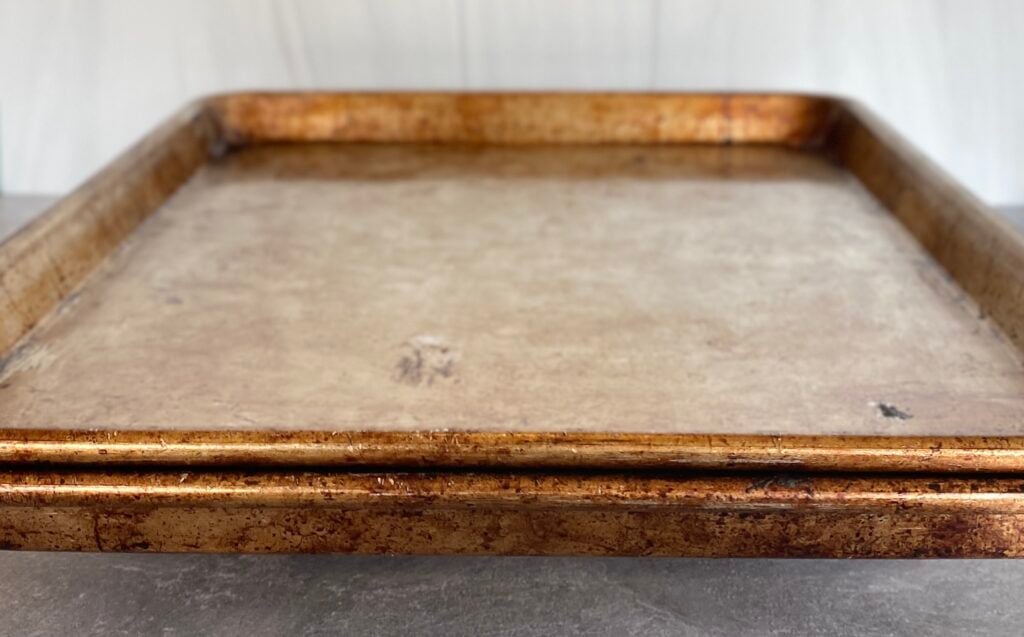
Sheet pans come in full size, two-thirds size, half size, quarter size, and one-eighth sizes. I use half sheet pans in my kitchen. As you can see, sheet pans have flat bottoms and short rims; I’ve found that this allows great air flow for things like cookies, though the sheet pan is a BOSS for savory cooking as well, since the rims keep juices from overflowing into your oven.
I am all about avoiding the auto clean function on my oven, folks.
Cookie sheets are a slight variation on the sheet pan; they have one raised side but otherwise have no other rims. Some cookie sheets (like these, from Airbake) also have a second, insulated layer between the oven rack and the cookies.
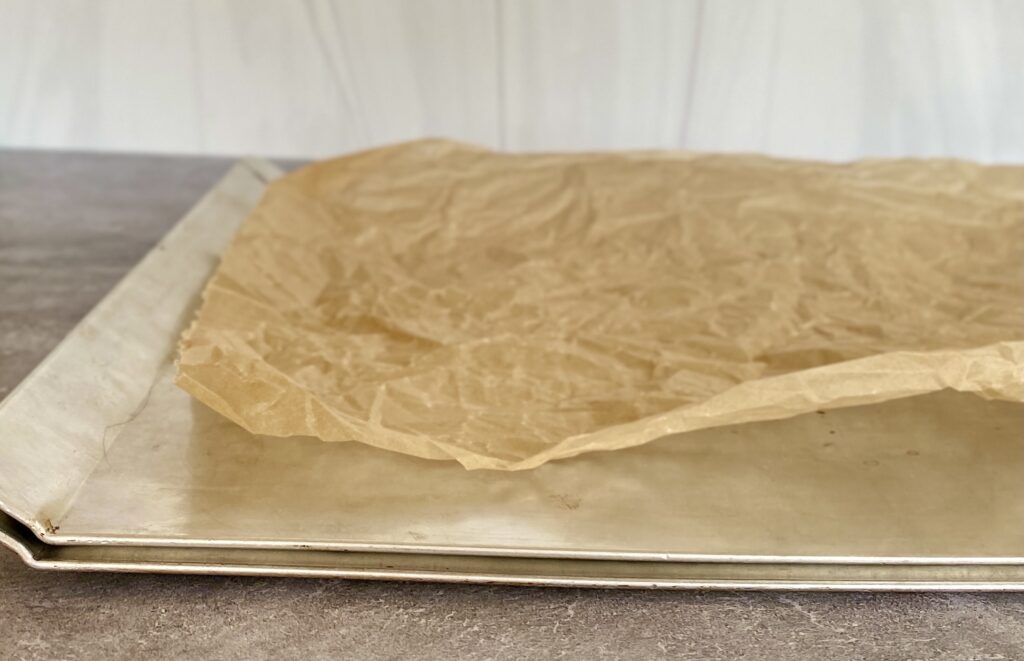
The theory behind the rim-less, extra insulated pan is that it provides more even cooking for short things like cookies, BUT I’ve found no appreciable difference in cookie outcomes with sheet pans and cookie sheets (and I’ve literally made TONS of cookies). When I’m doing a bakery-sized batch of cookies, I use both pans interchangeably. The cookie sheets retain heat for much, much longer though. (ouch)
One rule that I do have for cookie sheets and sheet pans is that I prefer light-colored pans. This is because I bake cookies using the convection function in my oven. I bake cookies high and fast in this kitchen, because they’re usually consumed almost as quickly as they’re done. But convection baking allows me to bake two dozen cookies at a time, which cuts my baking time in half.
Because I bake cookies so “high and fast” in my kitchen, I use light-colored pans to avoid having those cookies brown too much on the bottom. Since my ovens both have a hot spot, I also rotate pans about halfway through baking. But that’s another post altogether.
Cookie sheets and sheet pans are also great for bread! I usually try to bake bread right on top of a pizza stone, but sometimes a cookie sheet is the right tool for the job. For example, I recently used a sheet pan for this challah:
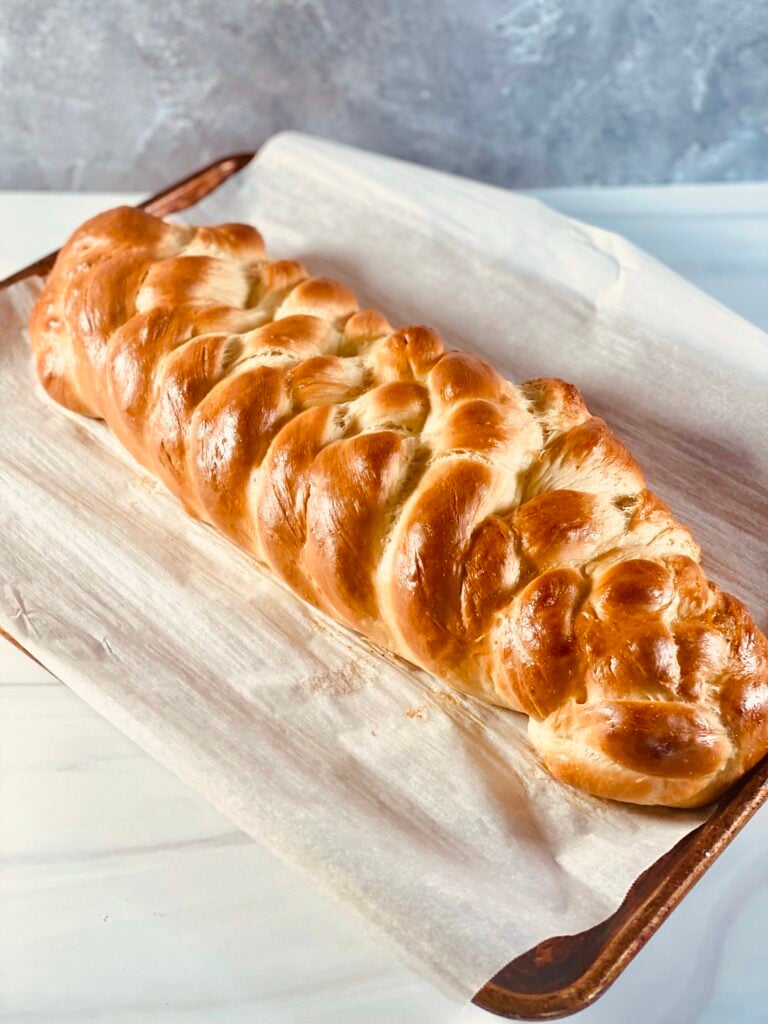
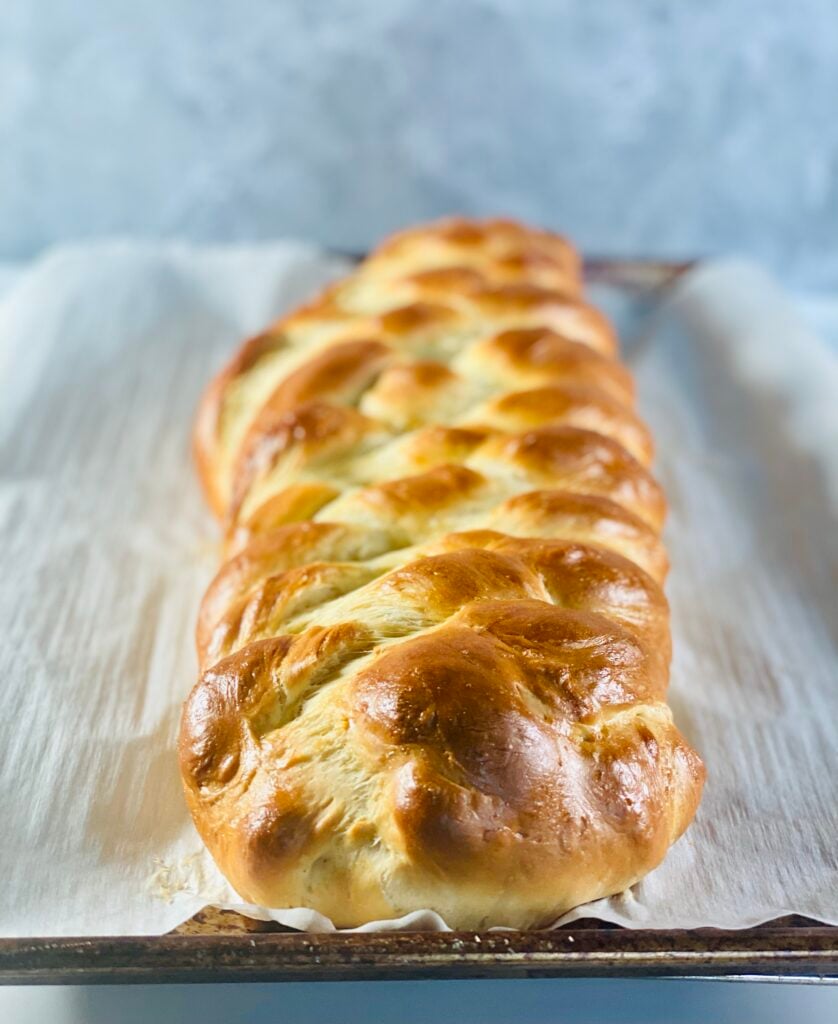
TL;DR version: cookie sheets and sheet pans are great multi-purpose pans for baking. Light-colored pans help avoid burnt-bottom cookies.
Pie Plates
I could honestly devote an entire post to pie plates. Not because I particularly adore pie plates, but because there are so many types of pie plates available. So I will stick with what’s in my kitchen.
I have ceramic and clear glass pie plates in my kitchen. I’ve used the glass pie plates since I started baking pies a few years ago, because I’m a weirdo and I want to know the exact moment that the bottom crust of a pie is done.
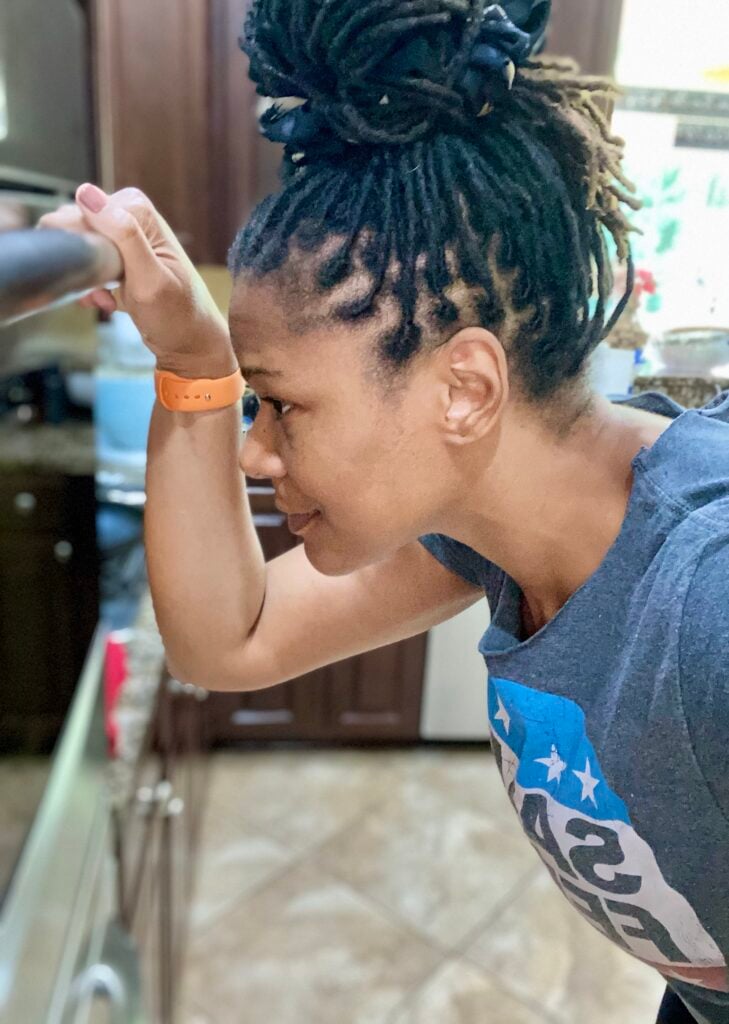
I picked up this habit as a beginning pie baker, and it’s been such a useful habit that I’ve just kept it.
A better baker might trust his/her instincts. I want to SEE. ???????????
See?
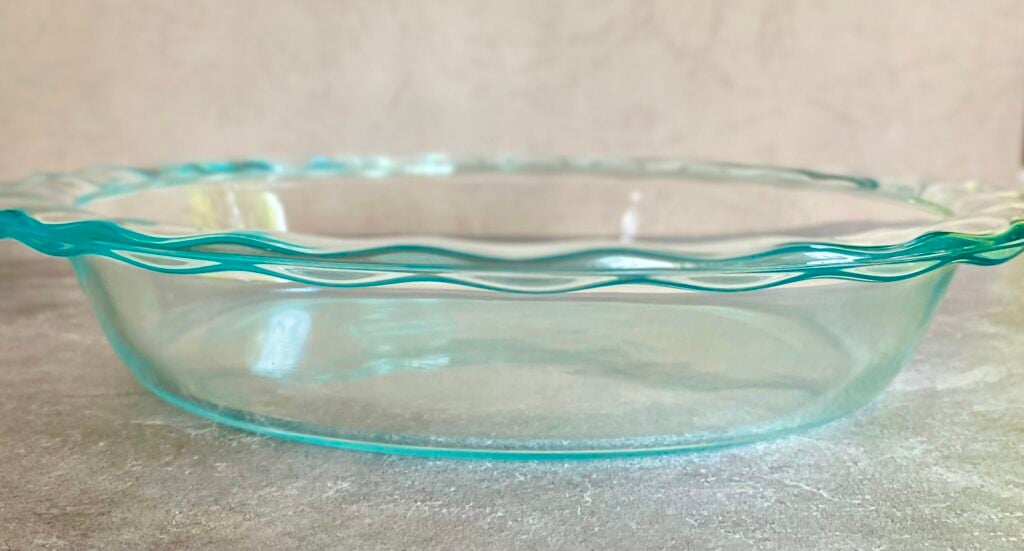
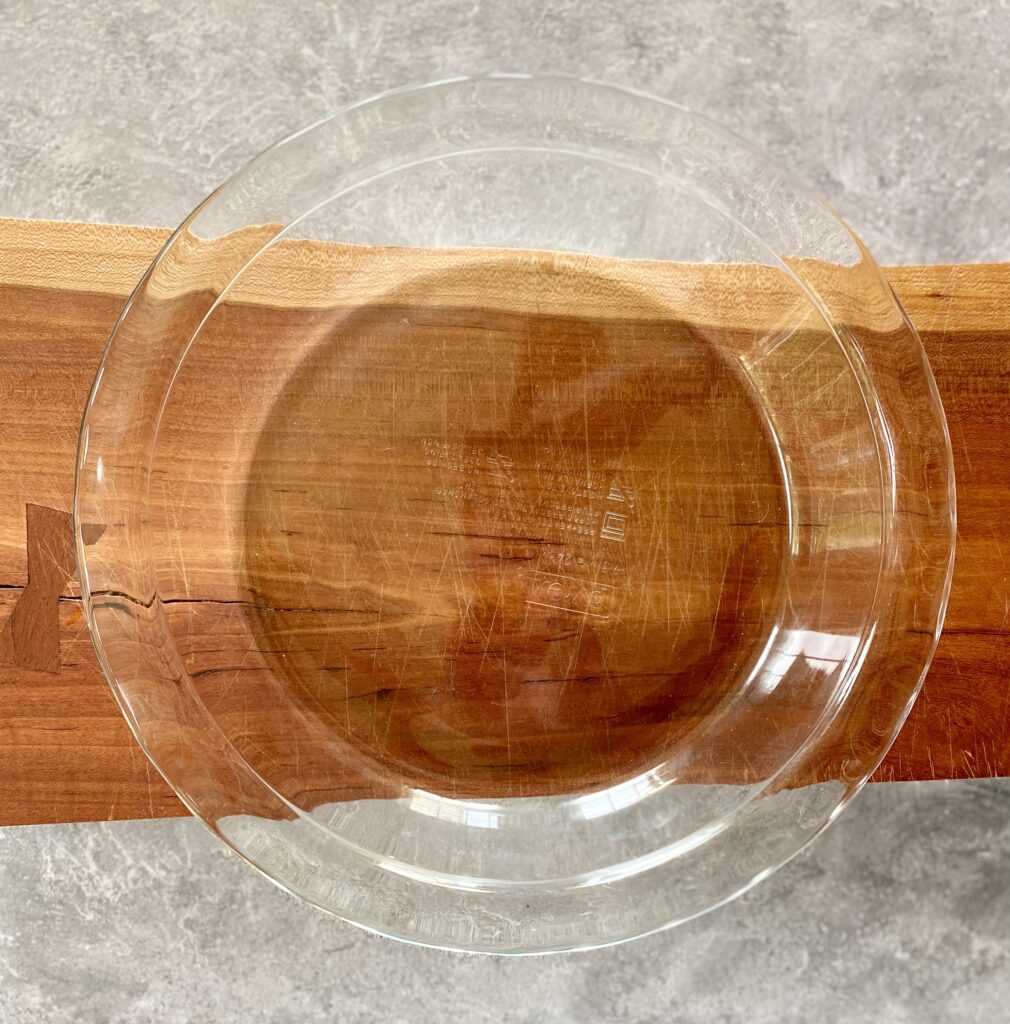
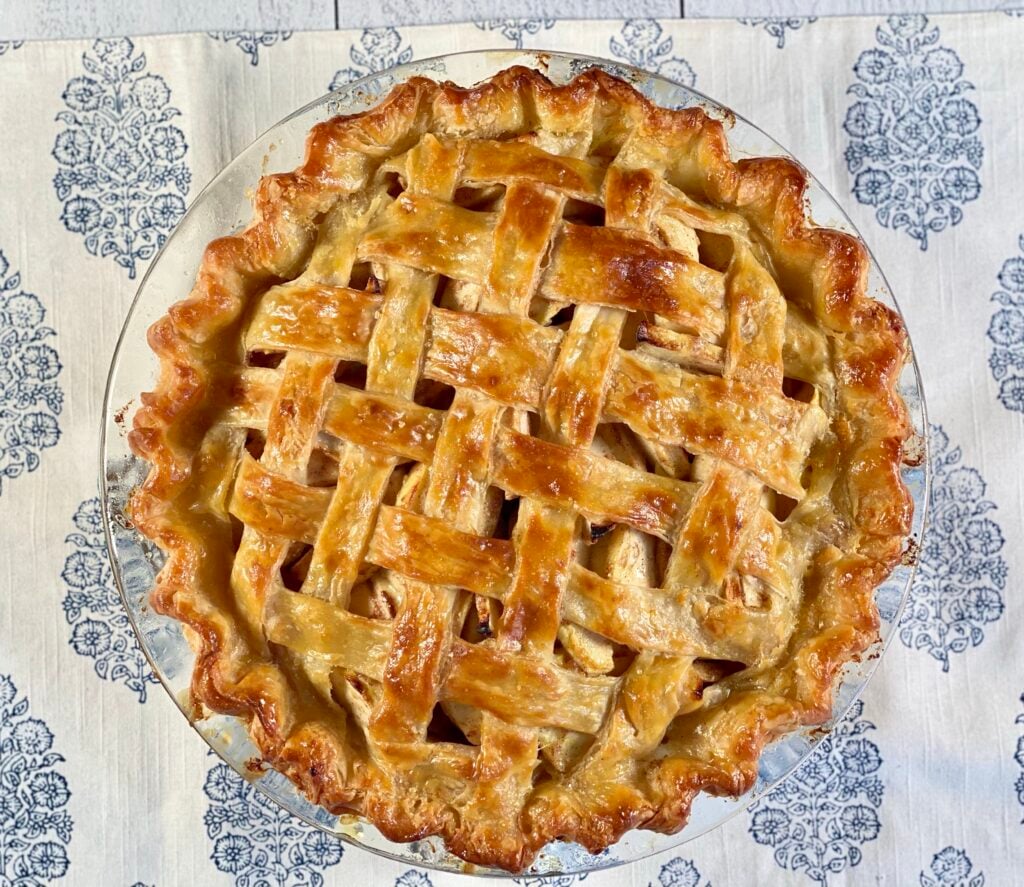
All jokes aside, glass pie plates can help you build tremendous confidence as a beginning pie maker. Pie baking can be a challenging endeavor, and having the right pie plate can be the difference between spending four hours to make a perfect pie, or spending four hours to make a pie with an underdone bottom crust. The latter…is not a happy moment.
But it’s still pie!
TL;DR version: Glass pie plates are best for beginners because you can see when it’s done!
Round Cake Pans
It’s very easy to get intimidated by the number of round cake pans available. They come at every price point, every diameter, and in seemingly every weight imaginable.
I have purchased more round cake pans than I would ever admit (especially if my husband ever sees this post ????). But I ultimately settled on Wilton cake pans because they’re just…consistent. I own these cake pans in 6″, 8″, and 9″ sizes, and I use them for personal and professional baking! They’re inexpensive and good and they turn out a consistent cake every time.
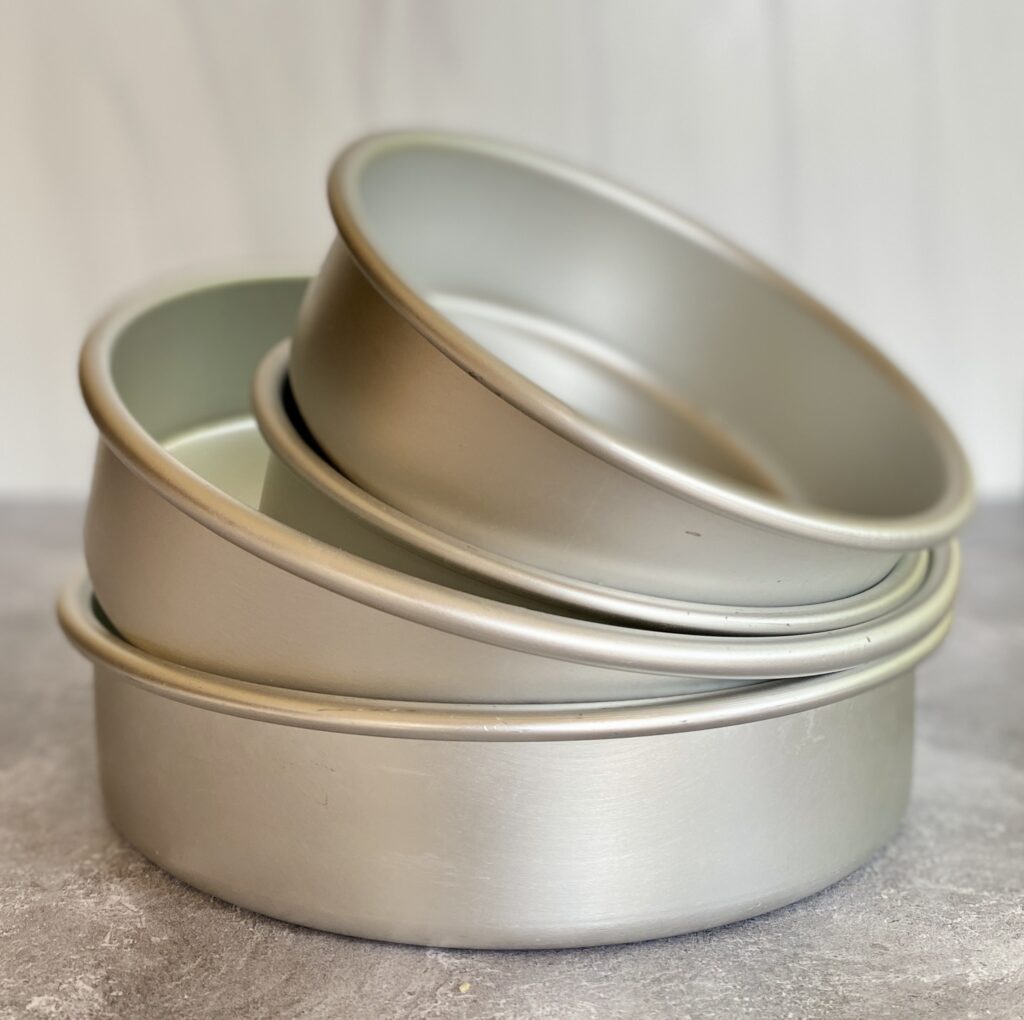
For the types of cakes that I bake in round pans, I prefer light-colored pans. These include classic “layer cake” cakes, like vanilla, funfetti, red velvet, chocolate, and carrot. While these all have vastly different flavor profiles, they all share one common goal: to not be dry.
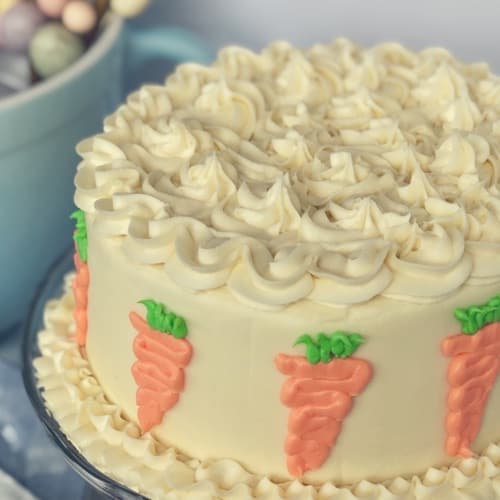
When making layer cakes, I want the most delicate, airy crumb possible. The extra heat from dark pans tends to have a drying effect on cakes, since the extra heat effectively bakes the cake at a higher tempererature in a shorter amount of time. Cakes are temperamental and they demand the proper oven temperature, so the best way to control that is with a good oven thermometer and some light-colored cake pans. Stalking Watching your cakes while they bake can help too!
TL;DR version: for layer cakes, light-colored cake pans are the bees’ knees. Dark pans have a drying effect that can lead to an unpleasant finished texture.
Bundt Pans
I have consumed my weight in pound cake many times over the course of my life. In my bakery, pound cakes and cookies are some of the most popular items.
I make all of my pound cakes in bundt pans, and it’s been both the most rewarding and frustrating experience in my baking experience.
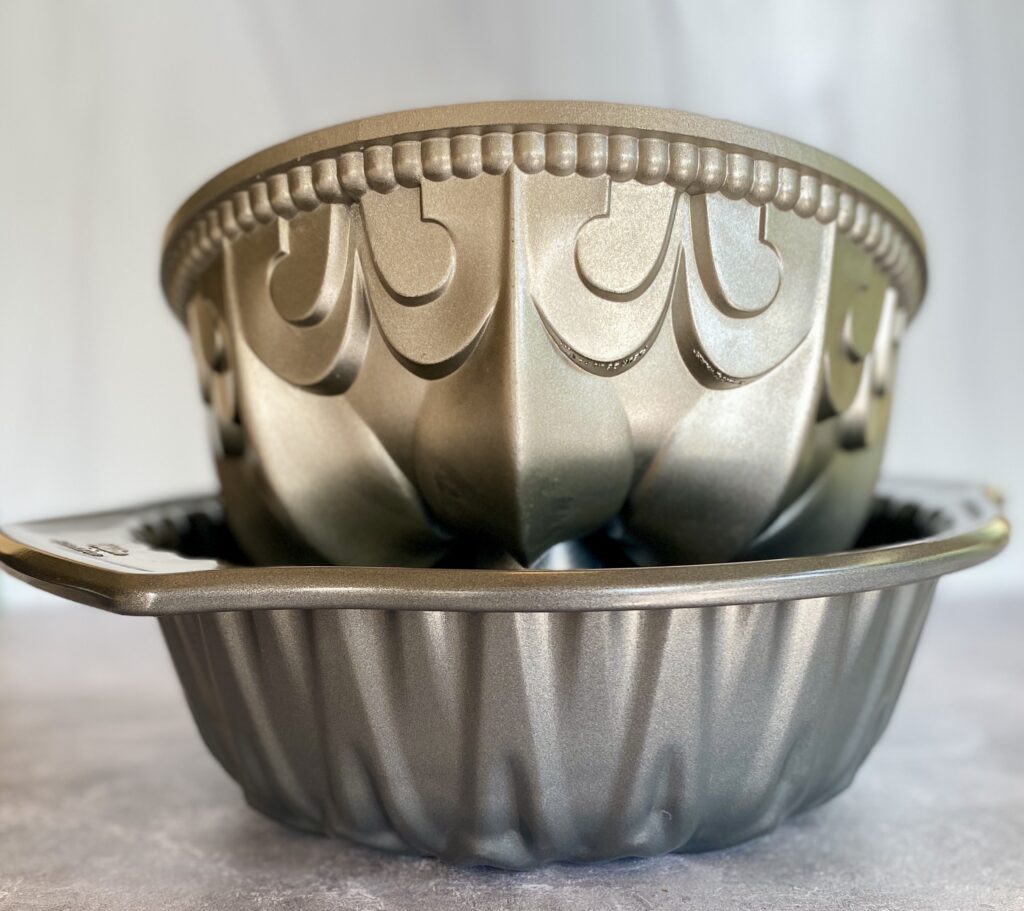
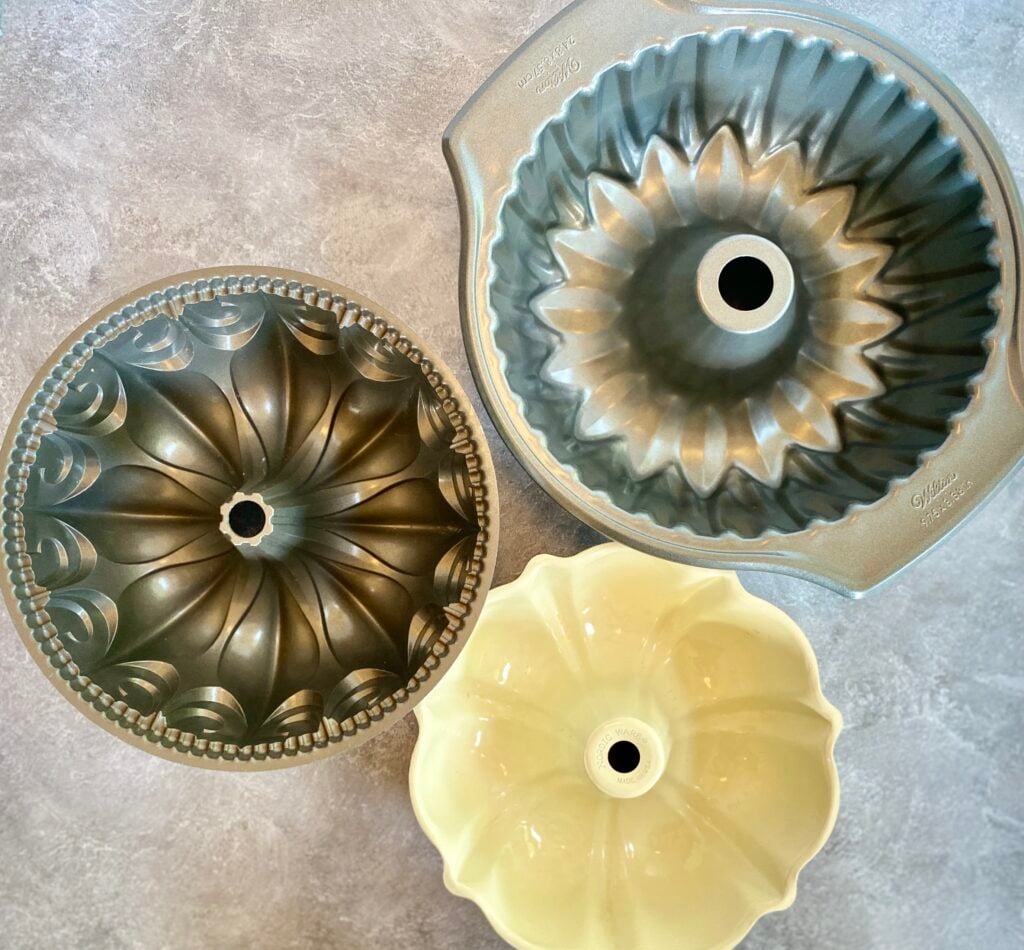
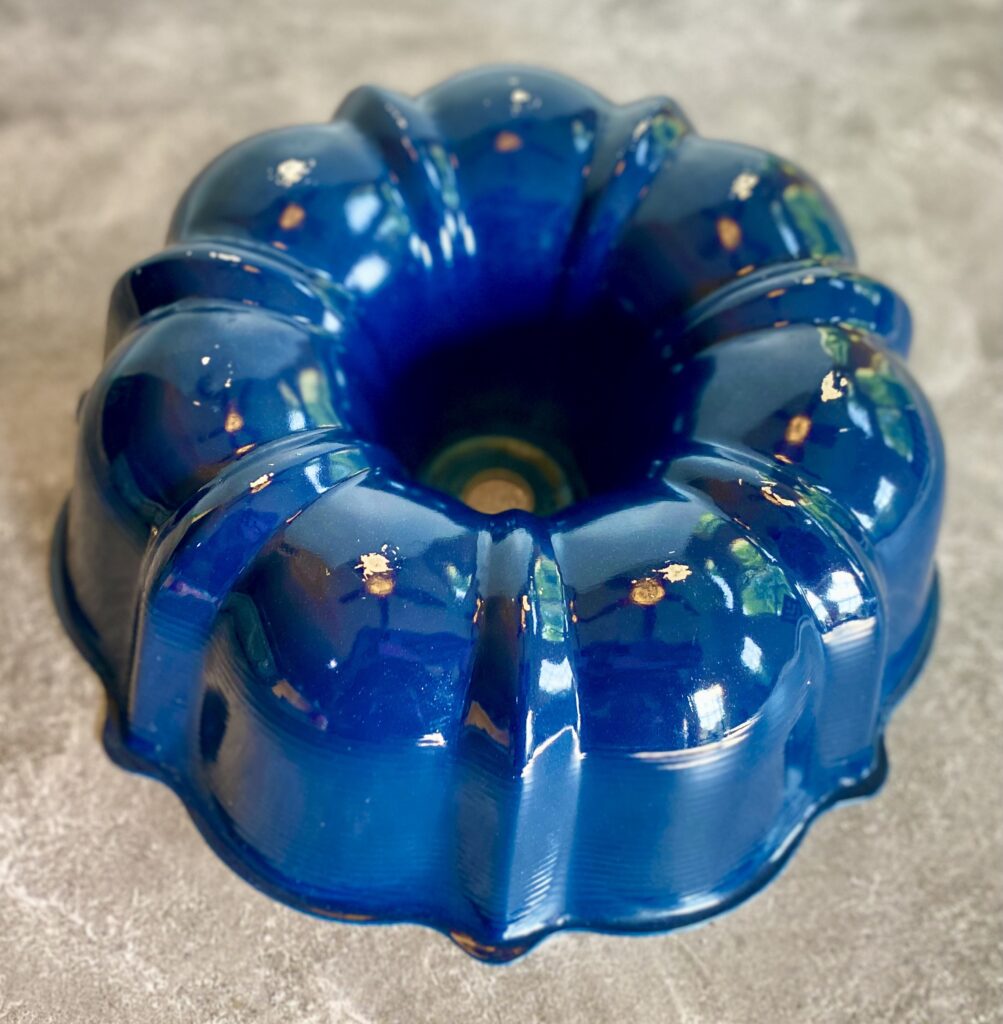
Bundt pans are my favorite pans because of the thousands or ornate designs they can make with your cake. BUT those ornate designs demand that you grease every corner of that pan. If you don’t grease your pan properly, you risk losing large chunks of your cake, OR EVEN WORSE, having your whole cake stick in the pan.
Listen:
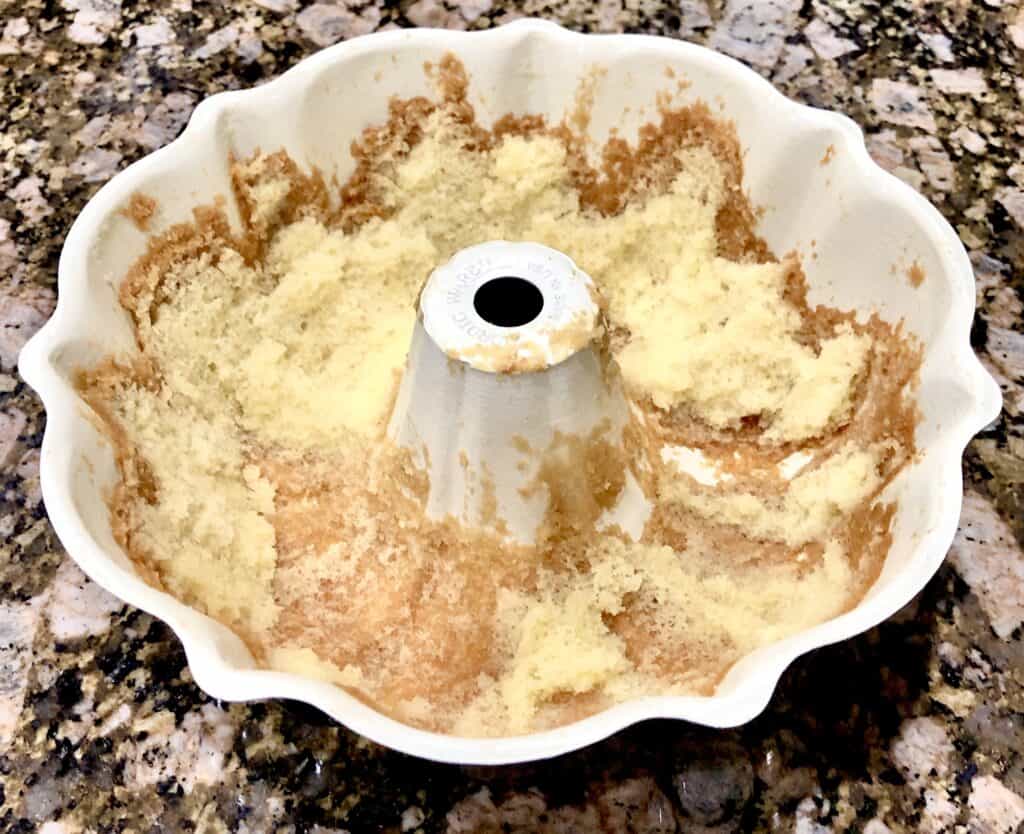
I avoid this outcome at all costs. Luckily, the cost to avoid this outcome is low, since a good greasing with butter and flour will help your cake release every time.
When it comes to pound cakes, if you want a beautifully caramelized exterior, dark cake pans are IT.
Let me explain.
By definition, pound cakes are loaded with all of the ingredients that help cakes stay moist (I know). So, the sugar, the eggs, the buttermilk…all of those actively help your pound cake remain dense and flavorful and NOT DRY.
With pound cakes, I absolutely love a beautiful, carmelized exterior. Kind of like this:
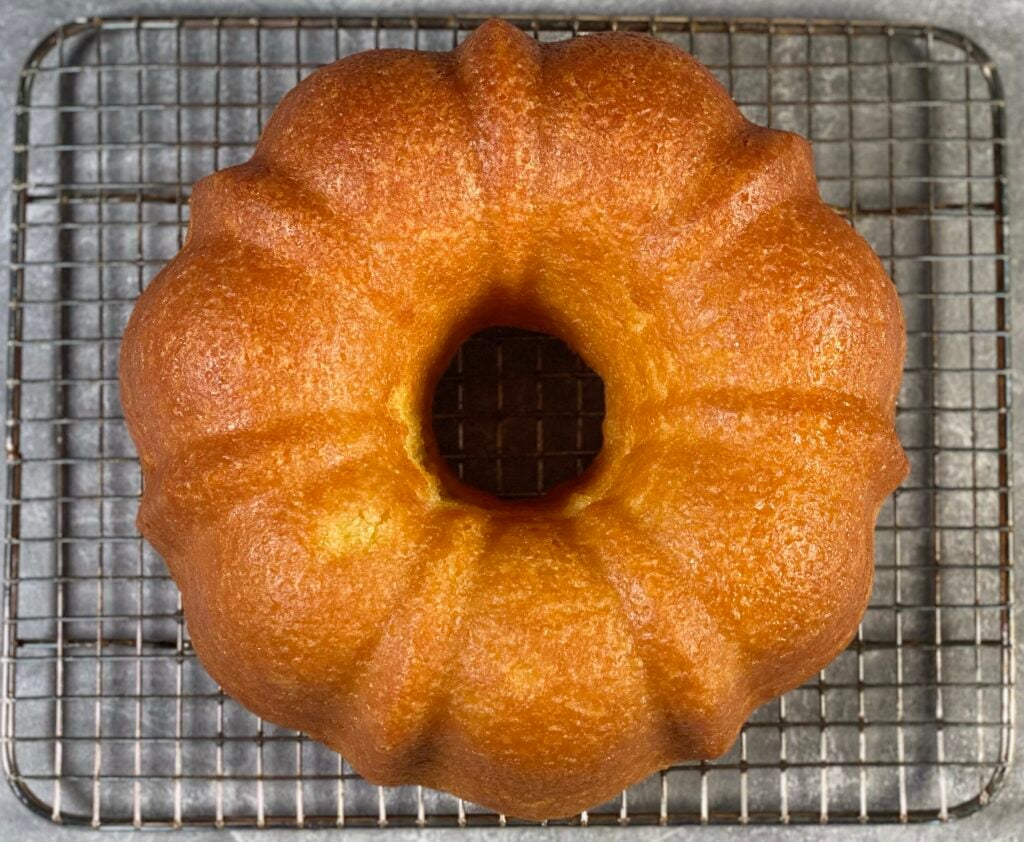
To get this, though, a cake has to really absorb heat from the pan, or it has to bake until it’s nearly dust. Clearly, I prefer the former.
Knowing that bundt cakes are infused with all of those delicious, moisture-aiding properties makes me confident that my pound cakes will survive the additional heat from dark bundt pans (within reason…you still can’t bake it forever). I currently have bundt pans from Nordic Ware and Wilton, and when I want a gorgeous crust, I reach right for the Wilton bundt pans.
While the Nordic Ware bundt pans don’t necessarily create the caramelization that my dark Wilton pan creates, there’s no competition when it comes to the ornate designs that Nordic Ware bundt pans can create. Lately, when I want a centerpiece bundt cake, I reach right for my Nordic Ware bundt pans.
TL;DR version: For a deeply caramelized pound cake, dark pans are key. Pound cakes can take the heat. Also, butter + flour = release.
Glass Baking Dishes
Also known as the casserole dishes, I use 9″ x 13″ and 8″ x 8″ glass baking dishes mainly for breakfast buns. For instance, for cinnamon rolls? Glass baking dishes are key:

This purpose of this ridiculous foodie thirst trap is to show that, with a glass baking dish, you can actually see when the sides of your cinnamon rolls (or other breakfast buns) are done. Since the aim is pillowy-soft with just a hint of al dente chew, it’s a huge bonus to be able to see what’s happening under the rim of the pan.
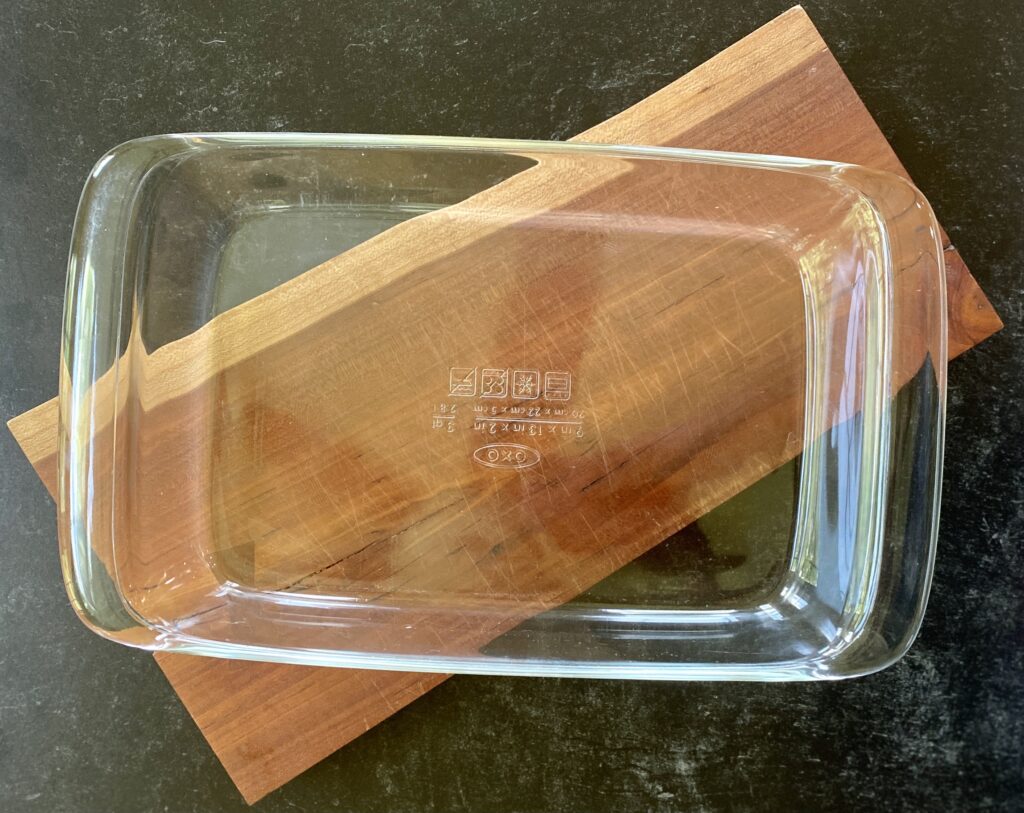
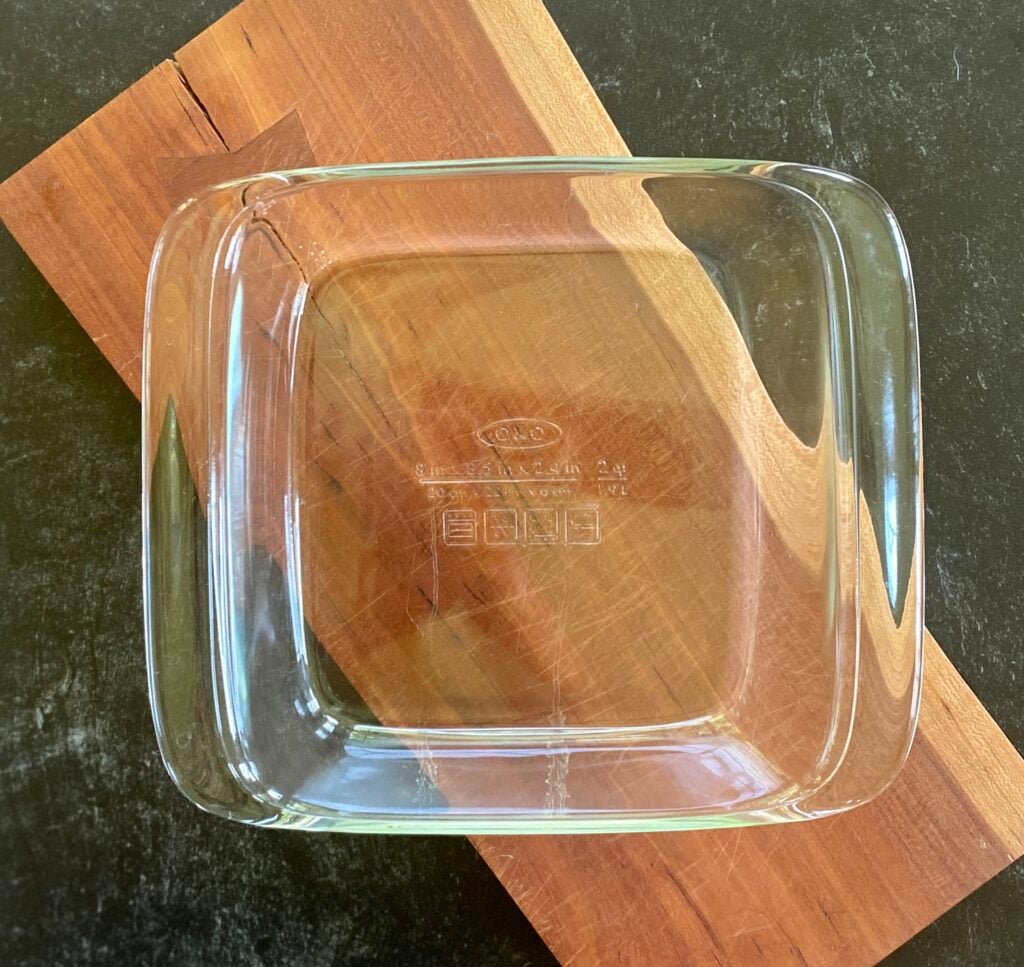
I don’t use 9″ x 13″ metal baking dishes for breakfast buns, because I find that they get too crispy and dark for my liking. BUT this is absolutely a personal preference! As with everything baking, the best way to figure out what works for your taste is to try and try again!
TL;DR version: for special breakfast treats like cinnamon rolls, glass baking dishes for the win!
Sheet Cake Pans
Sheet cake pans are different from sheet pans because sheet cake pans have higher sides than sheet pans. The higher sides create structure for the larger cakes that we commonly see at kids’ birthday parties and cookouts.
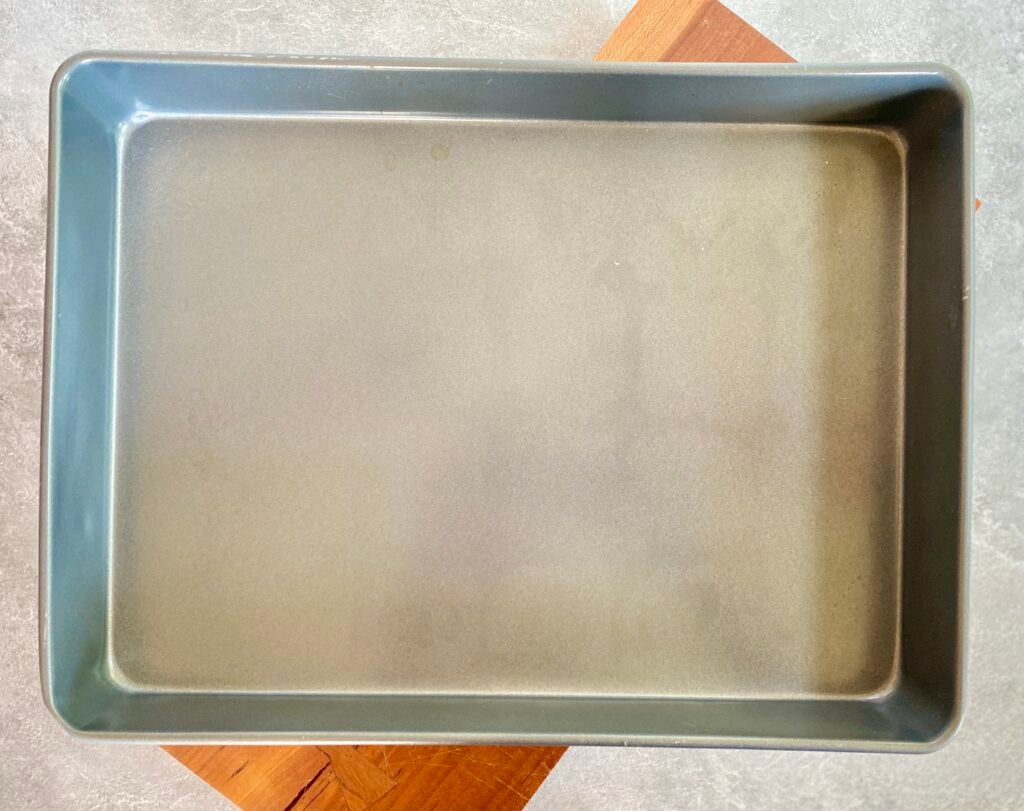
My relationship with sheet cakes is…complicated. I’m going to tell you, Family, that it’s very difficult to bake something as large as a half sheet cake or a full sheet cake and not have a dry product. While it’s possible, it’s arduous, and I prefer to work with smaller cakes to avoid the stress.
BUT, like you, I’m constantly hunting for the best techniques, so when I find the best sheet cake technique, I’ll be sure to shout it from the rooftops! Or at least post it on this blog.
It is ironic, then, that I absolutely adore my dark-colored, half and quarter sheet-sized Wilton cake pans. I use them exclusively for my famous dinner rolls. I am particularly partial to my quarter sheet-sized pans for this task; the beautiful golden color that results, combined with the slight flakiness of that first bite, makes me reach for my quarter sheet every time.
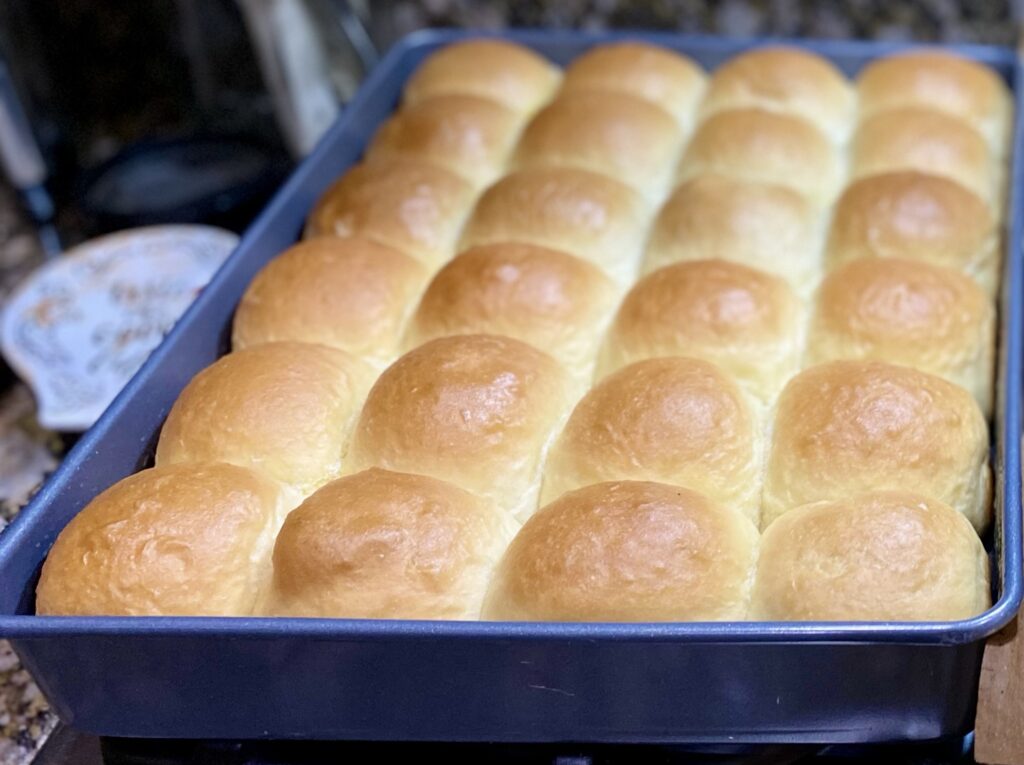
I love these pans so much for dinner rolls. So much so that I keep them exclusively for that use.
As much as possible, I try to find multiple uses for most of my kitchen tools, because it means buying fewer kitchen tools. HOWEVER, I will break that rule every day for these quarter sheet pans. It’s worth it to clean and store these pans every week, just for the sake of making these wonderful dinner rolls.
I *should* mention that, like pound cakes, my dinner rolls contain eggs, milk, and honey. So, based on my experience, they can take the extra heat from the dark pan.
TL;DR version: quarter sheet cake pans cannot be beat for beautiful dinner rolls.
Loaf Pans
Loaf pans can be used to make sandwich loaves, pull-apart breads, or quick breads. For traditional white breads or milk breads, I prefer light loaf pans, since there’s not a lot of extra fat and moisture to counteract the extra heat.
For quick breads, I let my spirit guide me. Some days, I want a beautiful, caramelized crust on my banana bread to counter the soft interior texture.

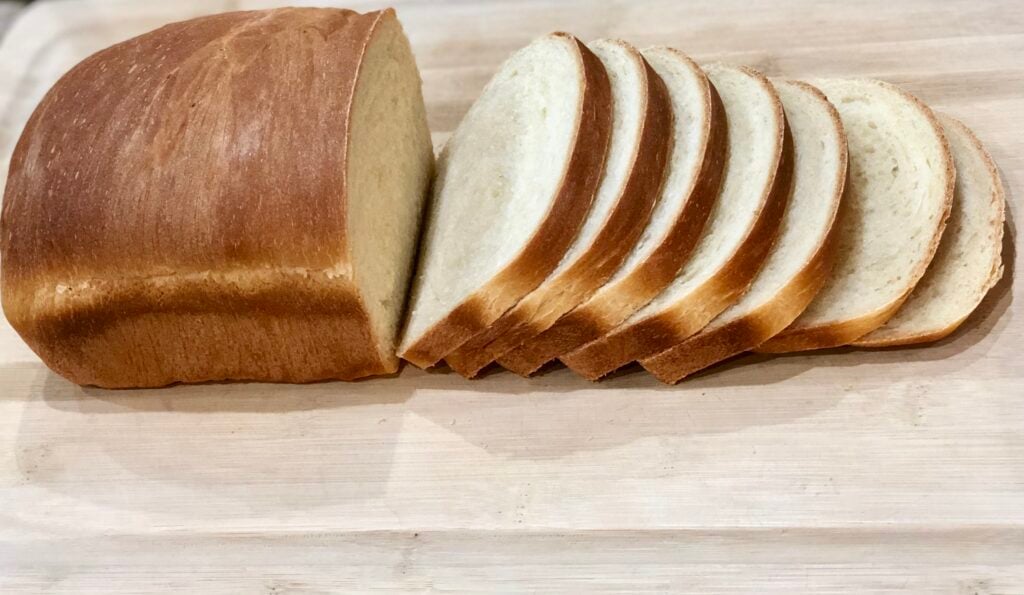
Other days, I use a light-colored loaf pan to create a delicate zucchini bread through and through. This is a classic example of when personal preference rules the day!
TL;DR version: For lean breads and milk breads, light loaf pans are best. For quick breads, think about your personal preference! If you like a more caramelized crust for your quick breads, choose a dark loaf pan. For tender crusts on your quick breads, light loaf pans are the way to go.
Muffin Pans
Muffin pans are another type of pan that come in several different variations. There are light and dark muffin pans, silicone and metal muffin pans, and mini, standard, and jumbo muffin pans.
I don’t have any silicone bakeware in my kitchen, so I don’t have an opinion about their effectiveness. But I started with standard-sized metal muffin pans at the beginning of my journey, and I have yet to find a need to add any additional muffin pans to my repertoire.
And y’all, I bake LOTS and LOTS of muffins and cupcakes. I even had a whole cupcake-themed birthday party. It featured over two hundred cupcakes, all made by yours truly.
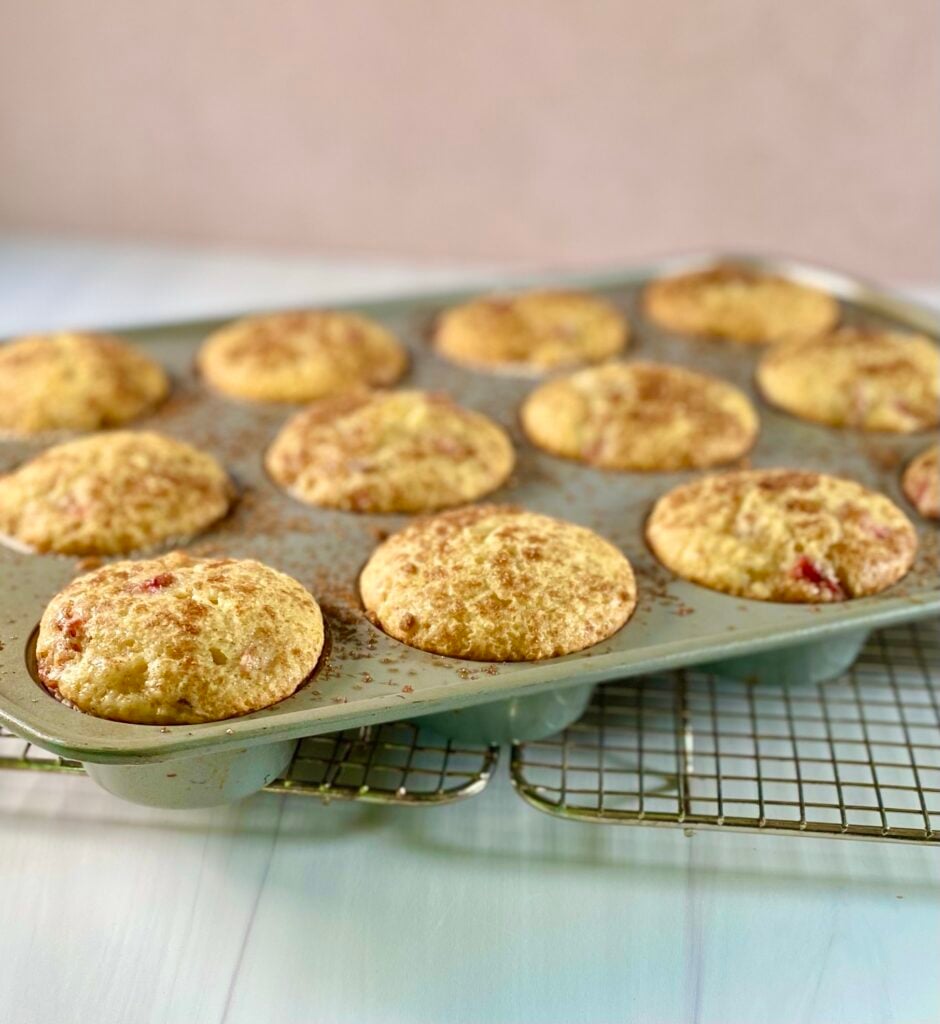
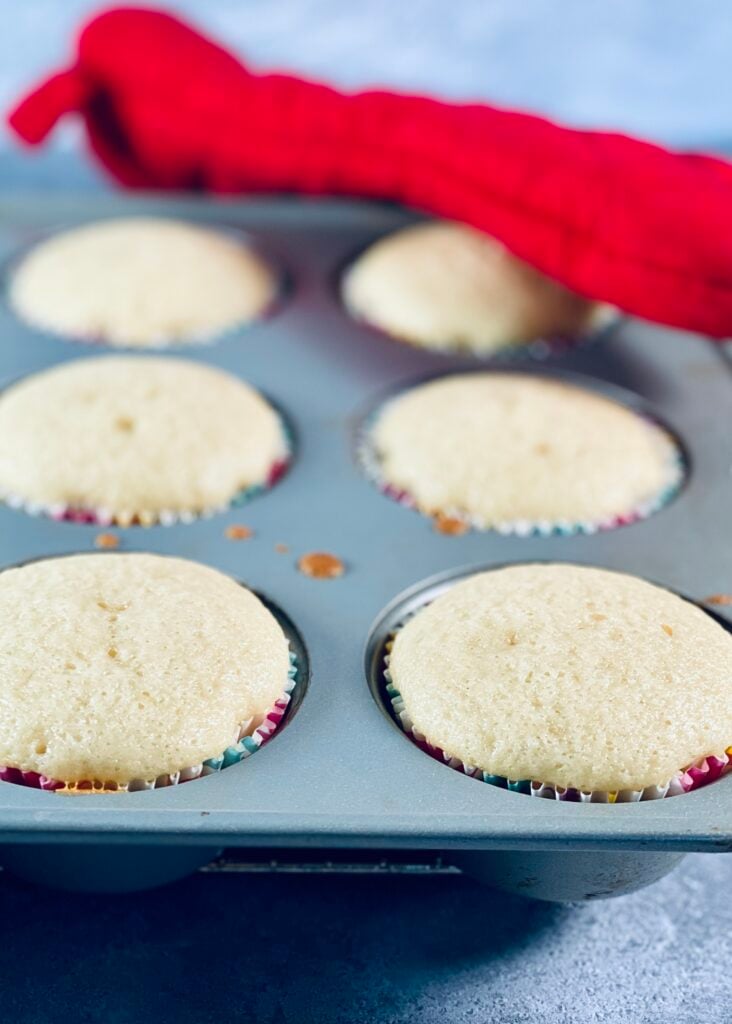
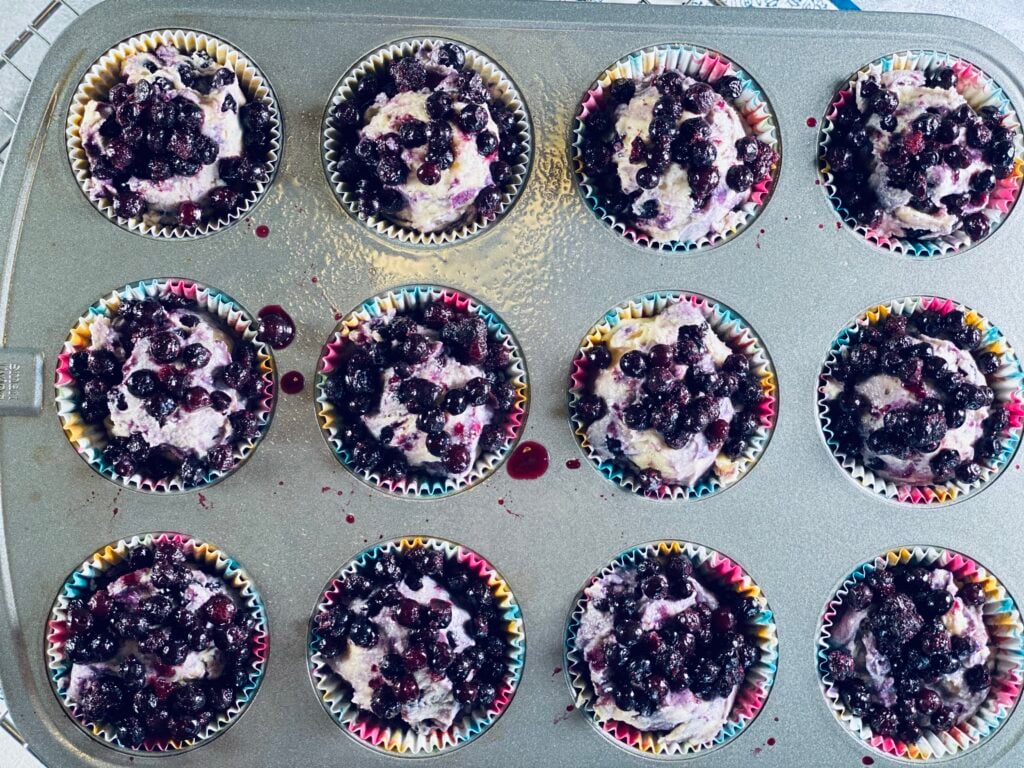
But I have not yet been moved to try mini muffin pans, jumbo muffin pans, or silicone muffin pans.
Sometimes, you just keep using what works.
I have both dark and light muffin pans, but I do prefer using the light muffin pans when I can. Muffins and cupcakes are such small cakes that they can overbake easily. The extra heat produced by a dark pan will almost always produce a darker bottom on muffins and cupcakes, and could ultimately lead to a much more dry finished product.
Best Pans for Beginners
Family, I know that this post has been a lot. So, I wanted to share with you that you don’t have to have all of these pans to start baking. Clearly, if you’re making something specific, you’ll need a specific kind of pan, but if you’re building a shopping list for a good overall starter set for baking, I recommend the following (I’ve provided links for my favorites):
- Two sheet pans
- Two 8″ round cake pans
- One 12-cup standard muffin pan
- One quarter-sheet cake pan
- One loaf pan
The rest can wait, unless you’re brave enough to make pie right out of the gate. In that case, take a look at my Sunday Session post about melt-in-your-mouth apple pie for technique tips, grab these Pyrex pie plates and have a ball!
Conclusion
I hope this post helps you understand some bakeware basics for home kitchens. I also hope that his post helps to take some of the intimidation out of baking, by literally giving you the tools for a good foundation. Don’t hesitate to contact me at hello@beginwithbutter with any questions about the bakeware featured here. And don’t forget to subscribe while you’re here so that you can get these amazing baking tips right to your email!
Thanks for stopping by! ???? ??



